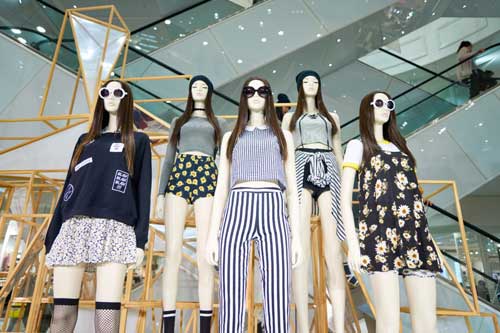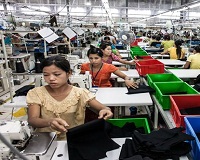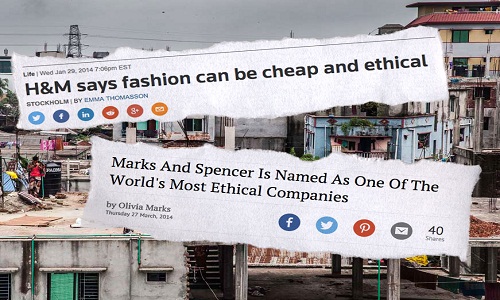FW
"While consumers and retailers alike are vouching for the benefits of going green, the real picture is quite different. People are still lured to fast fashion and discard clothes faster than ever before. Why has there been a stark conflict between mindset and interest? Scientists say shopping makes people feel good enough to ignore ethics, and it’s hard to turn down a good deal. The pleasure areas of the brain light up when consumers are pursuing something they want, and once they have invested time"

While consumers and retailers alike are vouching for the benefits of going green, the real picture is quite different. People are still lured to fast fashion and discard clothes faster than ever before. Why has there been a stark conflict between mindset and interest? Scientists say shopping makes people feel good enough to ignore ethics, and it’s hard to turn down a good deal. The pleasure areas of the brain light up when consumers are pursuing something they want, and once they have invested time, energy and money, sunk cost bias makes it hard to let go of the item they have grown attached to during the search.

Scientific studies suggest fast fashion plays into consumers’ neurological pathways by giving them not only pleasure from the act of looking for clothes but also the pleasure of getting a good bargain. A University of Michigan study found the price of an item or how much a person liked it didn’t alone explain the amount of pleasure experienced during shopping. It was how much the person liked it and what he or she paid for it. So when a shopper finds a top at Zara that fits well, sees that it only costs $19.99, and remembers the news story of a Zara customer finding a note from an unpaid factory worker sewed into the clothes, he or she faces a decision: Do I buy this shirt from a questionably responsible company, or do I keep looking for an option that matches my values?
Even though consumers must be sustainability oriented, it is this attitude that takes too much effort to change how they shop and to find another option that matches their budget, style and body type. In this continued doldrum, they tend to ignore or forget about the instances of human rights violations and carry on with their lives. Additionally, consumers also tend not to feel pressure to change their behavior if it is culturally appropriate. If their peers are paying for ethically sourced clothes, they are more likely to do the same. If they’re not, then the other party is also unlikely to change behaviour, because the risk of not changing is minimal. This suggests that until the majority of people pay a premium for ethically sourced clothing, most people will not change how they shop.
Riding the sustainability train
To lure consumers with ethical clothing, brands need to tell better stories during the shopping experience. The group Fashion Revolution ran a social experiment to test the effect of information at the point of purchase of cheap, unethically made clothes. They installed a vending machine that sold T-shirts for €2. Before the T-shirt was dispensed, the customers learned how that low-price point came to be: Garment workers in developing countries spent up to 16 hours a day in the factory and earned as little as 13 cents per hour. After receiving this information, the customers could opt to continue with the purchase or donate the 2 euros. Nobody in the experiment followed through with the purchase. Honest but emotional information presented at the point of purchase could influence consumer behaviour.
Companies could create more conscious shoppers if they educate them about what to ask for specifically. On average, prices need to increase by 1 to 3 per cent on individual garments to provide a living wage and safer working conditions, and consumers can pressure their favourite brands to make those changes. Consumers who want businesses to act responsibly need to communicate their expectations to their favorite brands. Brands can better tell stories that support consumers’ willingness to pay fair prices for goods. A little nudging both ways will help build a more sustainable fashion system that doesn’t degrade our environment and upholds everyone in it, from garment worker to consumer.
Training workers with soft skills like time and stress management, problem solving, communication and teamwork can have big a impact on productivity of workers and company profits, says a University of Michigan researcher. Achyuta Adhvaryu, Assistant Professor of business economics and public policy at Michigan's Ross School of Business, has studied the impact of soft skills in the garment industry in India over the past five years, and has now launched a foundation to take the message to other sectors in India.
Along with Anant Nyshadham of Boston College, Adhvaryu started the Good Business Lab last year. Anant Ahuja from Shahi Exports, India's largest garment manufacturing factory, is also a co-founder and CEO of the Lab. Adhvaryu says the goal with starting a foundation is to study interventions and incubate new ideas and serve as a platform to disseminate findings from the research.
With women making up roughly 35 per cent of the workforce the textiles and apparel sector employs more than 119 million workers in India. The garment sector is also the largest employer of low-skilled and semi-skilled female workers. The Good Business Lab is planning to establish 10 garment-sector skill enhancement centers for women at rural locations, informing job creation policy at the national level. It has received funding from the U.K. Department for International Development, the Indian government and Shahi Exports for the evaluation and implementation of the project.
The women who complete the training will be offered a job at one of the Shahi's garment factories and the lab will track the women over a period of time to see its impact.
Ethiopia’s export revenues from textiles and garments over the last eight months of the current fiscal year increased 23.1 per cent compared to revenue earned in the same period last year. However, this was 50 per cent below the target.
Managerial and technical limitations, inadequate supply of inputs, failure to meet international criteria and shortage of skilled manpower were among the limitations attributable to unsatisfactory export performance in the sector.
The country wants to diversify exports from agricultural products to strategic sectors like textile and garment manufacturing, through opening more than ten industrial parks in different parts of the country.
Ethiopia perceives textile and clothing supply chain as one of the country’s key targets for growth. By 2025, it aims at generating $30 billion from the export of garments and textiles. In the last five to six years, the textile and apparel industry in Ethiopia has grown at an average of 51 per cent, and more than 65 international textile investment projects have been licensed for foreign investors during this period.
In 2016, Ethiopia ranked second in attracting foreign direct investment in the textile and garment industry, next to Vietnam. It aims at becoming Africa’s manufacturing hub.
The government of Bangladesh is set to give 500 acres of land within the SEZ in Mirersharai of Chittagong to the Bangladesh Garment Manufacturers and Exporters Association (BGMEA) to enhance apparel exports. The Bangladesh Economic Zone Authority (BEZA), is set to sign a MoU with BGMEA. The Authority is of the view that this measure would incentivise garment makers garner $50 billion from export orders by 2021.
Paban Chowdhury, Executive Chairman, BEZA disclosed BGMEA has targeted apparel exports worth $50 billion by 2021. The government has decided to provide them the land so that they can set up new factories, create more employment and earn more from exports.
Chowdhury announced the BEZA was looking at providing BGMEA a further 1,500 acres of land inside the same zone and it would complete development inside the zone by this year and investors could start setting up factories by March next year. Investors will enjoy exemptions from VAT on electricity and taxes on sale and self-generated or purchased electricity for 10 years. All purchases, excluding petroleum products, will get VAT and sales tax exemptions, he added.
Siddiqur Rahman, President, BGMEA, says they would allocate the land for setting up garment and backward and forward linkage industries. Anyone from Bangladesh and abroad can purchase land at the zone for establishing garment factories.
The quest by big retail chains in the US to offer fast fashion -- on-trend apparel delivered before it goes out of style -- remains a challenge. The stakes are high to make fast fashion work. A rapidly changing assortment of trendy clothes helps drive customers into stores, and potentially stave off the encroachment of online retailers.
In the last couple of years, people started realizing they have to speed up. And one of the reasons is the consumer has really sped up. As consumers jump from one trend (and brand) to the next faster than ever, US retailers are collectively being forced to pivot away from the traditional model, which values low costs above all else. The methods they’ve adopted vary widely.
For now, few US retailers can match the fast-fashion prowess of European competitors such as Inditex and H&M. These companies pioneered the model by taking flexibility to the extreme, via airlifted merchandise, small order sizes and an accelerated design process.
A transition to fast fashion is also complicated as most US retailers depend on suppliers, while a company like Zara is vertically integrated -- allowing more control from start to finish. That means, for US apparel vendors, the acceleration has to occur across multiple companies.
Jeanologia, a Spanish specialist for sustainable technologies for garment finishing, has been researching for over 20 years on how to transform the jeans industry. It develops products in an eco-efficient way, produces an eco-sustainable product and brings a sustainable product to the market. Almost 35 per cent of the five billion jeans produced every year are made with Jeanologia technology.
In a few years, it may be possible for production to use zero water and create zero waste, increase productivity and reduce time to market and poverty and foster economic growth. Jeanologia continuously works at increasing awareness and involving everyone while reducing the water footprint and without losing competitiveness or compromising on design and quality.
During the past month, Jeanologia technology has led to a saving of 8,00,000 cubic meters of water. This saving has been possible thanks to the laser, ozone, and e-flow technology being used in the 60 countries Jeanologia works in.
The combination of the company’s technology has contributed to a saving of around eight million cubic meters of water in 2017. The company’s technology has allowed the elimination of potassium permanganate, pumice stone, manual scraping and traditional washing at the same time as considerably reducing chemical use.
"While leading companies have taken efforts to curb issues of worker underpayment, yet the goal seems too far-fetched. As the world’s second-largest apparel company — after Inditex, which owns Zara — H&M said it felt a sense of “shared responsibility” when it came to persistently low wages, an issue as endemic to the global garment industry as unrelenting hours, unsafe environments, and rampant verbal, physical, and sexual abuse. In a statement, it said that it has always been our vision that all textile workers should be able to live on their wage."

While leading companies have taken efforts to curb issues of worker underpayment, yet the goal seems too far-fetched. As the world’s second-largest apparel company — after Inditex, which owns Zara — H&M said it felt a sense of “shared responsibility” when it came to persistently low wages, an issue as endemic to the global garment industry as unrelenting hours, unsafe environments, and rampant verbal, physical, and sexual abuse. In a statement, it said that it has always been our vision that all textile workers should be able to live on their wage. We believe that the wage development, driven by for example governments in some countries, is taking too long, so we want to take further action and encourage the whole industry to follow. With size comes responsibility, and we have the ability to contribute to change.

In line with this, H&M in 2013 announced to deliver a ‘fair living wage’ policy for more than 850,000 workers across 750 factories by the end of 2018. As we are nearing the said date, trade experts have started weighing the result of the same and industry critics and worker union feel that the company has failed upto its said goal. While Cecilia Tiblad Berntsson, Social Sustainability Manager, H&M, stated the company has always been clear on what its goal is; to set the foundation and mechanisms needed for fair living wages to be paid by suppliers. H&M has an ongoing dialogue with stakeholders and report annually both to stakeholders and media about the activities and actions within the fair living wage strategy. According to her, 2018 will mark the ‘first milestone’ in an overarching strategy to address the issue. H&M’s focus may be redirected to where the local need is greatest and where there is a possibility to scale up effectively.
Analyst’s views
Taking a leaf from prevailing issue, Dominique Muller, Director Policy at Labour Behind the Label, a not-for-profit organization based in the UK, says brands can sometimes use this lack of agreement over calculations as a way to stall efforts at pursuing living wages, according to. Furthermore, it’s in the interest of governments to keep the minimum wage low, in part because they don’t want brands to abscond to other countries in pursuit of cheaper labour. He added there is a lot of push from brands to make sure that not only the government keeps wages low but also the supplier keeps wages low. And then suppliers and industry associations will say to the government, ‘Look, you can’t increase wages because then we wouldn’t get the orders from big brands.’
Judy Gearhart, Executive Director, International Labor Rights Forum, a human-rights organization based in Washington, DC, elaborates to promote real change, a living-wage benchmark remains an indispensable tool. A living wage benchmark quantifies what workers need to live decently, so that they can support a family above the poverty line and still be able to have some discretionary spending and the ability to save. Adheer Bahulkar, Partner – retail practice of global strategy, AT Kearney, has another view to share. For most brands this is not a priority by itself because while more than two-thirds consumers say they want better living conditions for workers, less than half of the same consumers are actually willing to pay more for their purchases.
Setting an example
A garment worker’s wage is only one to three per cent of the total cost of most clothing, according to the Clean Clothes Campaign. This means, if brands want to pay their workers a living wage, they can. In December, Labour Behind the Label noted it would cost H&M only 1.9 per cent of the $2 billion it made in 2016 to pay all its Cambodian workers the additional $78 per month they would need to achieve a living wage. To approach the problem from a different angle, H&M would only have to reallocate one year of its annual advertising budget to muster up living wages for its Cambodian workers for six and a half years.
To set an example, Patagonia was an early adopter of the Fair Trade standard, beginning with the launch of 11 Fair Trade-certified women’s products in 2014. Currently, the outdoor-apparel brand pays a premium on some 200-plus men’s, women’s, and children’s products. The extra money goes directly to workers who made the garments, and they form a committee that decides how to spend it. Maya Spaull, Senior Director – Apparel and Home Goods, Fair Trade USA, say in essence, when you purchase a Fair Trade-certified product, it’s a guarantee that it was traded in a more ethical way and really that boils down to safer working conditions, improved livelihoods, and protections for the planet.
Vietnam’s textile and garments exports to China have exponentially increased in recent years. The average annual growth of the country’s exports remained more than 20 per cent for the past three years. The import value of textiles and garments from China accounted for over 42.7 per cent of the country’s total imports and rose over 12 per cent last year.
The value of Vietnam’s exports to China is nearly four times higher than that of the Republic of Korea and nearly five times higher than that of Taiwan - the two major import markets of Vietnam in recent years. Vietnam’s fiber exports to China benefit due to a zero per cent tariff under the ASEAN-China FTA, while products from other markets have to pay a three to five per cent duty.
The Regional Comprehensive Economic Partnership (RCEP) between Asean and the countries of China, Republic of Korea, Japan, India, Australia and New Zealand is expected to boost Vietnam’s exports to China. By the end of 2017, China was among the top five consumers of Vietnam’s textile and garment products. Though Vietnam is the world’s leading textile and garment exporter Chinese products dominate the domestic market. Vietnam estimates it can export higher numbers to China from 2018.
Pakistan’s textile exports grew 7.17 per cent during July to February of the ongoing financial year. The growth enhanced the country’s overall exports during the period. These results have been achieved due to export-friendly policies and renewed efforts toward seeking better market access. The positive trend in the international demand and exchange rate correction are also expected to help sustain this rising trend in the coming months.
The main growth driver was the value-added textile sector. Exports of readymade garments went up 13.08 per cent. Exports of knitwear increased 13.3 per cent. Exports of bedwear went up 4.51 per cent in value terms. Exports of made-up articles, excluding towels, increased 7.32 per cent. Art, silk and synthetic textile exports grew by 80.08 per cent. Exports of cotton yarn witnessed an increase of 1.87 per cent and exports of cotton cloth recorded growth of 0.04 per cent.
However, exports of cotton carded tumbled by 97.87 per cent. Exports of tents, canvas and tarpaulin also declined 39.49 per cent. On the other hand, imports went up by 17.09 per cent during the first eight months of the current financial year as against the same period last year.
China will hold hosiery purchasing expo (CHPE) from March 26 to 28, 2018. Global fashion enterprises will attend the event, which has become one of the most distinctive and influential events in the region.
The core competitiveness of the fair lies in its capability to attract nearly 10,000 professional visitors from more than 50 countries and regions at home and abroad every year. Domestic and foreign industrial clusters, as well as international hosiery enterprises from Japan, Spain, Pakistan, South Korea, Egypt, Indonesia and Sri Lanka, will display their premium socks products on the same platform.
With booming of domestic consumption and growing economy, the strategy of high-end domestic trade has been introduced in the exhibition, which in turn will further enhance the competitiveness of the exhibition, thus helping China evolve from a large socks producer to an industrial power. The Fashion Accessories Expo (FAE) will be held concurrently. The strong alliance between CHPE and FAE will also combine two single product fairs in an industry exhibition covering multiple products. For this edition, the display area of FAE will be 30,000 sq. mt. with more than 600 foreign and domestic exhibitors and above 15,000 professional visitors from 60 countries and regions expected to attend the event.












